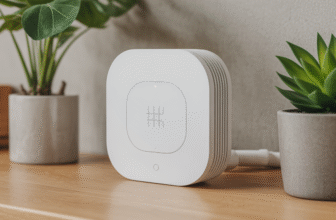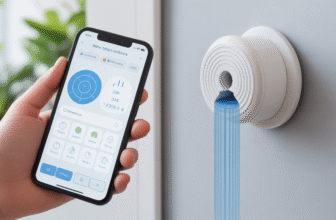
best IoT-enabled Garage Door Opener Under £200: Engineer’s Deep Dive into smart Home Innovation
The proliferation of IoT devices in smart homes is driving a new wave of innovation in traditionally mundane appliances, with the garage door opener becoming a centerpiece for convenience, security, and automation. For developers,engineers,and investors eyeing the smart home market,the challenge lies in balancing features,interoperability,and cost-especially when navigating under a stringent budget such as £200.
This deep dive provides a comprehensive evaluation framework and detailed analysis of the best IoT-enabled garage door openers priced under £200 available in the UK market, focusing on technical attributes, integration adaptability, security posture, and user experience. We explore key engineering tradeoffs, connectivity standards, firmware extensibility, and deployment scenarios to help informed stakeholders make optimized decisions.
”smart garages continue to redefine the standard of home entry – ongoing advances in IoT connectivity and cybersecurity are making affordable innovation accessible like never before.”
Understanding the Core Components of IoT Garage Door Openers Under £200
mechanical vs. Electronic Controllers: What’s Inside?
IoT-enabled garage door openers typically incorporate an electronic controller board that interfaces with traditional mechanical opener motors. Under £200,the design trend leans towards leveraging existing mechanical infrastructure,integrating with electronic modules that add connectivity and monitoring features without replacing the entire mechanism.
These controllers contain microcontrollers (MCU) such as ESP32, STM32, or ARM Cortex-based chips, paired with relay drivers to actuate the door motor. Cost constraints influence component choices,especially for power management,wireless modules,and sensor arrays. Developers should look for open-source firmware support or documented APIs to maximize extensibility.
Connectivity Protocols: Wi-Fi, Zigbee, Z-Wave, Bluetooth, and Beyond
Connectivity defines a garage opener’s IoT credentials. Wi-Fi remains the most common and practical choice for sub-£200 devices thanks to module cost, ease of integration with home networks, and direct cloud dialog.
In contrast,Zigbee and Z-Wave are popular in tightly meshed smart home ecosystems but often require seperate hubs,pushing total system cost beyond budget. bluetooth Low Energy (BLE) offers proximity control advantages but generally lacks remote cloud unlocking out-of-the-box.
ESP32 modules with Wi-Fi provide a versatile platform for under £200 openers due to their scalability and rich SDKs.
Security Architecture in Budget iot garage Door Openers
Common Vulnerabilities in Garage Door IoT Systems
Security is paramount when automating entry points-yet often overlooked in budget-oriented designs. Typical vulnerabilities include weak authentication schemes, unencrypted communications exposing devices to replay attacks, and outdated firmware channels lacking secure update mechanisms.
The absence of hardware-backed root-of-trust elements or secure enclaves is common at the sub-£200 price point, increasing reliance on software-based protocols and challenge-response authentication over TLS/SSL.
Recommended Security Features for Developers and Buyers
- Mutual TLS authentication with cloud servers
- Encrypted Wi-Fi communication and OTA firmware updates
- Role-based access control and multi-factor user authentication
- Comprehensive audit logs for door activity
- Firmware signed with secure cryptographic keys
Integrating or verifying these in a garage door opener under £200 demands scrutiny of device datasheets, security whitepapers, and trust model disclosures from manufacturers.
Evaluating the Leading IoT Garage Door Openers Under £200: Technical Profiles
Chamberlain MyQ Smart Garage Hub - Accessible Yet Feature-Rich
Chamberlain’s MyQ hub uses Wi-Fi (2.4GHz) and claims compatibility with major voice assistants.The MyQ transforms traditional openers into IoT devices via a retrofit module. Priced under £200, its ecosystem robustness and secure cloud API make it a developer favourite.
The hub supports smartphone app control with end-to-end encrypted communication facilitated via AWS IoT Core infrastructure. However, some early versions lacked open APIs, limiting custom integration for developers unwilling to operate only within the Chamberlain ecosystem.
Meross MSG100 Smart Garage Door opener Controller – Ideal for DIY and developers
Meross pushes affordability and openness using a Wi-Fi based solution compatible with Alexa, Google Assistant, and Apple HomeKit. It has an intuitive mobile app and supports MQTT for third-party integration with smart home platforms like Home Assistant.
Its firmware supports OTA updates, and the device includes integrated sensors to detect door state. the simplistic wiring and modular integration under £150 make it attractive for engineers seeking rapid deployment with a minimal footprint.
Architectural Blueprint of IoT Garage Door Openers Priced Under £200
Conceptual Architecture Breakdown
The architecture of an IoT-enabled garage door opener under £200 typically involves four critical layers:
- Physical actuator interface: Relay or triac module controlling the door motor.
- Embedded control module: MCU with Wi-Fi radios managing sensor inputs and communication.
- Cloud communication layer: Secure messaging API between the device and cloud backend supporting remote control and telemetry.
- User interface ecosystem: Mobile app, voice assistant skills, and optionally web portals for device and access management.
understanding each layer helps in troubleshooting, enhancing device firmware, or customizing integration with existing IoT deployments.
firmware Architecture and OTA Update Strategies
Firmware in these devices balances feature exposure and security. Standard design patterns include partitioned firmware images to support fail-safe OTA updates and rollback capabilities. ESP-IDF (Espressif IoT Advancement Framework) and PlatformIO are common environments providing continuous integration pipelines for building and signing firmware.
Developers should prioritize cryptographic signature verification onboard, ensuring only trusted firmware installs to mitigate supply chain attacks.
Interoperability and Protocol Support for Under-£200 Garage Openers
Integrating with Home Automation Frameworks
The best IoT garage door openers under £200 provide open APIs or are compatible with platforms like Home Assistant’s MyQ integration or Meross’ MQTT support. This allows embedding opener control into broader automation workflows, such as geofencing triggers, event logging, and security alerts.
Leveraging these integrations,engineers can orchestrate seamless smart home experiences without expensive proprietary ecosystems.
Voice Command and AI Assistant Compatibility Overview
Device compatibility with Alexa, Google Assistant, and Apple HomeKit is almost standard for these models. Certification processes ensure that voice commands map accurately to device intents and security contexts.
Developers building custom voice skills or automations must work with respective SDKs to handle user authorization and device revelation correctly.
Analyzing User Experience: Mobile App and Physical Interaction Design
Mobile Application Features That Matter
A great mobile app for under £200 IoT garage door openers balances simplicity, responsiveness, and reliability. Look for:
- Real-time door state feedback and alert notifications
- Instant open/close command execution with minimal latency
- Multi-user access management and logging
- Scheduling and geo-fencing capabilities
APIs that enable webhook callbacks and integrations with ecosystems like IFTTT unlock powerful automation beyond the app itself.
Physical Controls Integration: Buttons, Sensors, and Backup Systems
Despite digital enhancements, physical interface reliability remains essential. Best models offer manual override buttons, battery backup in case of power failure, and integrated sensors confirming door position to prevent accidents.
these features guarantee safety compliance while enhancing user trust in the automated system.
Challenges and Pitfalls in Sourcing Budget IoT Garage Door Openers
Compatibility and Installation constraints
Not all under-£200 IoT modules support all brands or mechanical door types. Some require proprietary motors; others necessitate rewiring or add-on sensors. Compatibility matrices and clear manufacturer documentation are critical before purchase.
Failure to correctly assess these aspects causes deployment delays or partial functionality.
Firmware Updates and Manufacturer Support
Many budget devices exhibit poor manufacturer update cadence leading to unpatched vulnerabilities or feature stagnation. Community-supported projects, open firmware, and modular hardware platforms mitigate this risk but usually require above-average technical skill.
Cost-Benefit Analysis: Features vs Price for Top Contenders
Comparison Table of Leading Models
*Prices approximate and subject to change based on retailer and availability*
Deployment Case Study: Smart Security for a Medium-Sized Residential Complex
System Design and Integration
A residential complex with 20 apartments implemented Meross MSG100 modules for all garage doors, integrating via MQTT into a centralized Home Assistant hub. This allowed security personnel to monitor door states and remotely control access, leveraging a Layer 7 firewall and VPN for secure remote management.
Event logs were streamed to an ELK stack (Elasticsearch, Logstash, Kibana) instance for audit and anomaly detection, highlighting unauthorized access attempts.
Lessons Learned and Optimization Strategies
- Firmware monitoring and routine OTA scheduling are necessary to patch emerging vulnerabilities proactively.
- Integration with biometric access control systems further enhanced security layering.
- User training reduced accidental lockouts and boosted technology adoption rates.
Future-proofing Your IoT Garage Door System Within Budget Constraints
Modular Hardware for Upgrade Flexibility
Opting for devices with modular hardware components - such as detachable sensor arrays or interchangeable connectivity modules – extends the useful life of an under-£200 garage opener,allowing incremental upgrades to future protocols like Matter or Thread.
Open Firmware and Community Ecosystem Leverage
Supporting open-source firmware projects or devices with Linux-based or ESP32 SDK-friendly ecosystems ensures that functionality can grow beyond manufacturer limitations. Developer communities often patch security flaws faster and introduce new features aligned with evolving IoT standards.
Optimizing Developer and Researcher Engagement With Budget IoT Garage Doors
APIs, SDKs, and Reverse Engineering Best practices
Since many sub-£200 devices restrict API access to preserve ecosystem control, researchers and developers should:
- Exploit MQTT or REST endpoints documented or discovered via network sniffing.
- Use firmware extraction and static analysis to ascertain undocumented features.
- Contribute to or consult with open-source projects such as Home Assistant integrations.
Key Performance Indicators (KPIs) for Evaluating Device Responsiveness
Measurable KPIs that engineers prioritize include:
- Latency from app command to door movement initiation
- Reliability rate of prosperous open/close cycles
- Security incident detection frequency
Business and Investor Perspectives: Market trends in Affordable IoT garage Openers
Growth Drivers and Consumer Preferences
Increasing smart home adoption among mid-market dwellers and DIY communities stimulates demand for gateway products priced attractively below £200. Additionally, growing emphasis on home security and convenience fuels investments in garage automation.
Leading vendors are enhancing ecosystem partnerships and licensing APIs to third parties, expanding the addressable market.
Risk Factors and Regulatory Considerations
Compliance with privacy laws such as GDPR and technical standards like ETSI EN 303 645 for consumer IoT security become differentiators. Investors must assess manufacturer adherence to these frameworks to mitigate reputational and regulatory risks.
“Affordable smart garage openers are poised to revolutionize access control, but sustainable innovation hinges on integrating open standards and robust security frameworks.”






